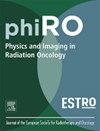A systematic review of the role of artificial intelligence in automating computed tomography-based adaptive radiotherapy for head and neck cancer
IF 3.3
Q2 ONCOLOGY
引用次数: 0
Abstract
Purpose
Adaptive radiotherapy (ART) may improve treatment quality by monitoring variations in patient anatomy and incorporating them into the treatment plan. This systematic review investigated the role of artificial intelligence (AI) in computed tomography (CT)-based ART for head and neck (H&N) cancer.
Methods
A comprehensive search of main electronic databases was conducted until April 2024. Titles and abstracts were reviewed to evaluate the compliance with inclusion criteria: CT-based imaging for photon ART of H&N patients and AI applications. 17 original retrospective studies with samples sizes ranging from 37 to 239 patients were included. The quality of the studies was evaluated with the Quality Assessment of Diagnostic Accuracy Studies-2 and the Checklist for Artificial Intelligence in Medical Imaging (CLAIM) tools. Key metrics were examined to evaluate the performances of the proposed AI-methods.
Results
Overall, the risk of bias was low. The average CLAIM score was 70%. A major finding was that generated synthetic CTs improved similarity metrics with planning CT compared to original cone-beam CTs, with average mean absolute error up to 39 HU and maximum improvement of 80%. Auto-segmentation provided an efficient and accurate option for organ-at-risk delineation, with average Dice similarity coefficient ranging from 80 to 87%. Finally, AI models could be trained using clinical and radiomic features to predict the effectiveness of ART with accuracy above 80%.
Conclusions
Automation of processes in ART for H&N cancer is very promising throughout the entire chain, from the generation of synthetic CTs and auto-segmentation to predict the effectiveness of ART.
人工智能在头颈癌基于计算机断层成像的自适应放疗自动化中的作用的系统综述
目的通过监测患者解剖结构的变化并将其纳入治疗计划,可以提高治疗质量。本系统综述探讨了人工智能(AI)在基于计算机断层扫描(CT)的头颈部(H&;N)癌症ART中的作用。方法截止2024年4月,对主要电子数据库进行全面检索。我们回顾了标题和摘要,以评估是否符合纳入标准:基于ct的成像用于H&;N患者的光子ART和人工智能应用。纳入17项原始回顾性研究,样本量从37例到239例不等。使用诊断准确性研究质量评估-2和医学成像人工智能检查表(CLAIM)工具对研究的质量进行评估。研究了关键指标来评估所提出的人工智能方法的性能。结果总体上偏倚风险较低。平均CLAIM得分为70%。一个主要发现是,与原始锥束CT相比,生成的合成CT提高了与计划CT的相似性指标,平均绝对误差高达39 HU,最大改善幅度为80%。自动分割为危险器官的描绘提供了有效和准确的选择,平均Dice相似系数在80 - 87%之间。最后,AI模型可以利用临床和放射学特征进行训练,以预测ART的有效性,准确率在80%以上。从合成ct的生成和自动分割到预测ART的有效性,ART治疗H&;N癌症过程的自动化在整个链中都是非常有前景的。
本文章由计算机程序翻译,如有差异,请以英文原文为准。
求助全文
约1分钟内获得全文
求助全文
来源期刊

Physics and Imaging in Radiation Oncology
Physics and Astronomy-Radiation
CiteScore
5.30
自引率
18.90%
发文量
93
审稿时长
6 weeks
 求助内容:
求助内容: 应助结果提醒方式:
应助结果提醒方式:


